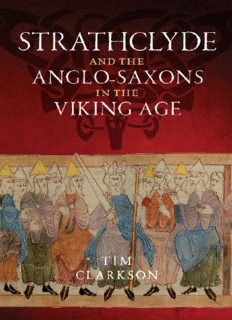
Strathclyde and the Anglo-Saxons in the Viking Age PDF
Preview Strathclyde and the Anglo-Saxons in the Viking Age
STRATHCLYDE and the Anglo-Saxons in the Viking Age First published in Great Britain in 2014 by John Donald, an imprint of Birlinn Ltd West Newington House 10 Newington Road Edinburgh EH9 1QS www.birlinn.co.uk ISBN: 978 1 906566 78 4 eISBN: 978 1 907909 25 2 Copyright © Tim Clarkson 2014 The right of Tim Clarkson to be identified as the author of this work has been asserted by him in accordance with the Copyright, Designs and Patents Act, 1988 All rights reserved. No part of this publication may be reproduced, stored, or transmitted in any form, or by any means, electronic, mechanical or photocopying, recording or otherwise, without the express written permission of the publisher. British Library Cataloguing-in-Publication Data A catalogue record for this book is available on request from the British Library Typeset by Hewer Text UK Ltd, Edinburgh Printed and bound in Britain by Bell & Bain Ltd, Glasgow CONTENTS List of Plates List of Maps Genealogical Tables 1 Cumbrians and Anglo-Saxons 2 Early Contacts 3 Raiders and Settlers 4 Strathclyde and Wessex 5 Athelstan 6 King Dunmail 7 The Late Tenth Century 8 Borderlands 9 The Fall of Strathclyde 10 The Anglo-Norman Period 11 Conclusions Notes Bibliography Index LIST OF PLATES 1.Hogback gravestones in Govan Old Parish Church 2.Govan Old Parish Church 3.Dumbarton Rock 4.Bamburgh Castle Govan in 1758: from Robert Paul’s engraving A view of the banks of 5. the Clyde taken from York Hill Aethelflaed, Lady of the Mercians: commemorative statue erected at 6.Tamworth Castle in 1913, showing Aethelflaed with her nephew Athelstan The Gosforth Cross, Cumbria: a tenth-century monument 7. displaying Anglo-Saxon and Norse influence 8.Anglo-Saxon cross near the east wall of All Saints Church, Bakewell Eamotum: the confluence of the rivers Eamont and Lowther near 9. Brougham Castle 10. Lowther Church, Cumbria 11. Dunmail Raise, Cumbria 12. St John the Baptist, Chester: ruins of the medieval church 13. The Giant’s Grave, Penrith Carham, 1018: view eastward along the River Tweed near the 14. probable site of the battle LIST OF MAPS 1.Early medieval Britain and Ireland 2.The North Britons in the Roman period 3.Northern Britain, sixth to eighth centuries 4.Govan in AD 900 The Solway region: Cumbric place-names of the Viking period [after 5. Higham 1993, 181] 6.Britain in the time of Edward the Elder, c.920 7.Strathclyde and northern Northumbria in the early tenth century 8.The meeting at Eamotum, 927 9.The location of Brunanburh: five popular candidates 10. North Lancashire and the ‘conflict zone’ of 937 11. St Cathroe’s pilgrimage 12. Strathclyde and Northumbria in the late tenth century Hogback monuments in southern Scotland / northern England and 13. sculpture of the ‘Govan School’ 14. Geographical context of the battle of Carham, 1018 15. Kingdoms and peoples, c.1050 16. Gospatric’s Writ 17. Southern Scotland and northern England in the twelfth century 18. David’s principality: ‘Cumbria’ in the Scottish kingdom, c.1120 GENEALOGICAL TABLES Kings of Alt Clut, fifth to ninth centuries, based on the Harleian pedigree of Rhun, son of Artgal. Names in italics are from sources outside the pedigree. The royal dynasty of Strathclyde
Description: